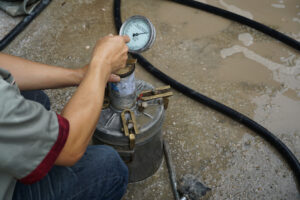ACI PRC-132.1-22, “Responsibility for the Care of Test Specimens for Acceptance of Concrete“, describes who should do what to ensure accurate acceptance testing. As a TechNote rather than a standard or a code, it’s not mandatory and so can’t be incorporated into a specification. Instead it lays out best practices for engineers and contractors to adopt.
Acceptance testing is a critical part of quality assurance. ACI 318‑19, Building Code Requirements for Structural Concrete, requires the evaluation of hardened concrete on the basis of compressive strength tests. ASTM C172 specifies how to sample the concrete at the point of delivery. ASTM C31 specifies the testing of the fresh concrete and the fabrication, curing, and transport of the specimens to the lab. Once they’re in the lab, ASTM C39 specifies the storage and testing procedures. The lab performing the tests must comply with ASTM C1077. ACI 318 incorporates all of these standards by reference.
On the construction site, however, practices often fail to meet the standards. Different studies have found that on-site curing met ASTM C31 about half the time or as rarely as 20% of the time. Why does that matter? Improper initial curing can reduce the compressive strength of the test cylinders by 20% or more. Considering that nearly every deviation from the procedures of ASTM C31 and C39 tends to bias the results low, any additional errors will just compound the problem.
We’ve discussed the costs of testing errors in terms of schedule, budget, and carbon footprint in a previous blog. Usually, the concrete producer adds extra cement to ensure the concrete meets the strength. The contractor and ultimately the owner will pay a higher cost. They may also get an inferior performance in terms of thermal cracking, shrinkage cracking, prestress losses, and deflections.
What ACI PRC-132.1 recommends
ACI PRC-132.1 assigns responsibility to the Engineer of Record, the contractor, and the testing lab to ensure that the testing consistently meets the standards. The Engineer of Record should:
- Specify the responsibility for initial curing in the construction documents.
- Ensure that the testing lab complies with ASTM C1077.
- Require that lab reports include all the information listed in ASTM C31 and C39, as well as exactly where the concrete was placed.
The contractor should:
- Schedule a pre-pour meeting to discuss responsibilities for maintaining the test specimens in accordance with ASTM C31.
- Inform the lab of the placement schedule.
- Notify them at least 1 day in advance of placement.
- Provide a secure location with water and power for initial curing.
- If the contract requires, provide an enclosed facility for initial curing.
- Provide access to the testing lab to sample the concrete and make and retrieve specimens.

The testing lab should:
- Sample the concrete in accordance with ASTM C172 and cast, cure, transport, and test the specimens in accordance with ASTM C31 and C39.
- Store the specimens without moisture loss and within the appropriate temperature range ASTM C31 requires. If special equipment or facilities are necessary to meet these requirements, include the cost in the bid for testing services.
- Report the data in compliance with ASTM C31 and C39, including the temperature range of the initial curing environment.
- Transmit these reports in a timely manner to the Engineer of Record, the contractor, the concrete producer, and any others as agreed at the pre-pour meeting.
A few last words
ASTM C1077 covers the lab’s personnel, facilities, QA program, and proficiency testing. However, the accrediting agency can’t police what happens on the construction site. In some locations concrete truck drivers are documenting their observations of poor practices.
The Engineer of Record should periodically review the standards in the construction documents. It’s important to know what the specification requires, and the only way to do that is to know what’s in the standards it references.
The testing lab should place min/max thermometers in the curing containers and maintain the temperature records for curing and transport to the lab. Concrete specimens are most vulnerable to damage and improper curing in the first 24 hours. Concrete that contains significant amounts of supplementary cementitious materials will be slower to gain strength, especially in cold weather. That makes it more vulnerable to damage at early ages.
According to ACI 318, a test requires at least two 6 x 12-in. cylinders or at least three 4 x 8-in. cylinders. It’s a common practice for a lab to break a single cylinder at 7 days “for information”. However, a single cylinder break means nothing on its own. If you want a test, do a test. The Engineer of Record can make clear in the pre-pour meeting how many cylinders constitute a test and and at what ages tests are necessary.
Once the technician is on site, making an extra cylinder or two doesn’t cost much. The real cost is in the testing. Occasionally that spare cylinder could be worth its weight in gold. For example, if one cylinder breaks low, you can break a spare cylinder to verify the strength. (Don’t discard the one that broke low without checking it for visible defects, though.) Or if you have to investigate low strengths, you can use a spare cylinder for petrography. Even the best petrographer can’t get much useful information from a broken cylinder.
